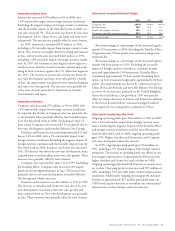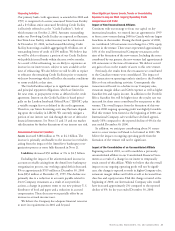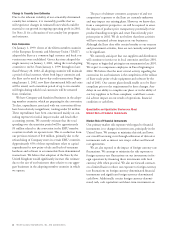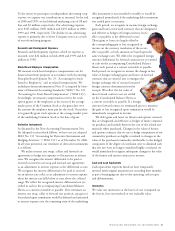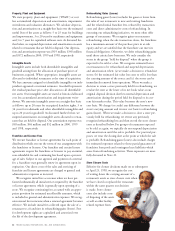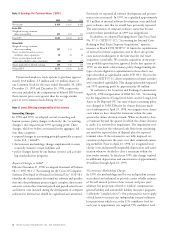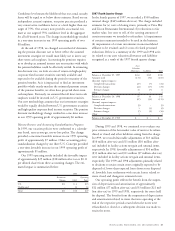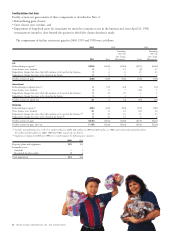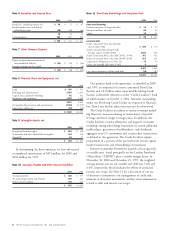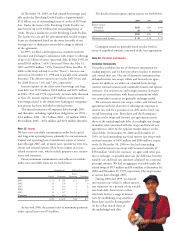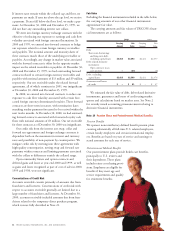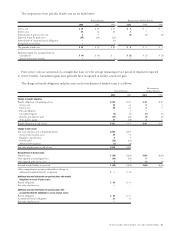Pizza Hut 2000 Annual Report Download - page 47
Download and view the complete annual report
Please find page 47 of the 2000 Pizza Hut annual report below. You can navigate through the pages in the report by either clicking on the pages listed below, or by using the keyword search tool below to find specific information within the annual report.
TRICON GLOBAL RESTAURANTS, INC. AND SUBSIDIARIES 45
To the extent we participate in independent advertising coop-
eratives, we expense our contributions as incurred. At the end
of 2000 and 1999, we had deferred marketing costs of $8 mil-
lion and $3 million, respectively. Our advertising expenses
were $325 million, $385 million and $435 million in 2000,
1999 and 1998, respectively. The decline in our advertising
expense is primarily due to fewer Company stores as a result
of our refranchising program.
Research and Development Expenses
Research and development expenses, which we expense as
incurred, were $24 million in both 2000 and 1999 and $21
million in 1998.
Stock-Based Employee Compensation
We measure stock-based employee compensation cost for
financial statement purposes in accordance with Accounting
Principles Board Opinion No. 25, “Accounting for Stock
Issued to Employees,” and its related interpretations. We
include pro forma information in Note 15 as required by State-
ment of Financial Accounting Standards (“SFAS”) No. 123,
“Accounting for Stock-Based Compensation” (“SFAS 123”).
Accordingly, we measure compensation cost for the stock
option grants to the employees as the excess of the average
market price of the Common Stock at the grant date over
the amount the employee must pay for the stock. Our policy
is to generally grant stock options at the average market price
of the underlying Common Stock at the date of grant.
Derivative Instruments
As discussed in the New Accounting Pronouncement Not
Yet Adopted section which follows, we have not yet adopted
SFAS No. 133 “Accounting for Derivative Instruments and
Hedging Activities,” (“SFAS 133”) as of December 30, 2000.
In all years presented, our treatment of derivative instruments
is as follows.
We utilize interest rate swaps, collars and forward rate
agreements to hedge our exposure to fluctuations in interest
rates. We recognize the interest differential to be paid or
received on interest rate swap and forward rate agreements
as an adjustment to interest expense as the differential occurs.
We recognize the interest differential to be paid or received
on an interest rate collar as an adjustment to interest expense
when the interest rate falls below or rises above the collared
range. We reflect the recognized interest differential not yet
settled in cash in the accompanying Consolidated Balance
Sheets as a current receivable or payable. If we terminate an
interest rate swap, collar or forward rate position, any gain or
loss realized upon termination would be deferred and amortized
to interest expense over the remaining term of the underlying
debt instrument it was intended to modify or would be
recognized immediately if the underlying debt instrument
was settled prior to maturity.
Each period, we recognize in income foreign exchange
gains and losses on forward contracts that are designated
and effective as hedges of foreign currency receiv-
ables or payables as the differential occurs.
These gains or losses are largely offset by
the corresponding gain or loss recognized in
income on the currency translation of the receiv-
able or payable, as both amounts are based upon the
same exchange rates. We reflect the recognized foreign
currency differential for forward contracts not yet settled
in cash on the accompanying Consolidated Balance
Sheets each period as a current receivable or payable.
Each period, we recognize in income the change in fair
value of foreign exchange gains and losses on forward
contracts that are entered into to mitigate the
foreign exchange risk of certain forecasted
foreign currency denominated royalty
receipts. We reflect the fair value of
these forward contracts not yet settled
on the Consolidated Balance Sheets as
a current receivable or payable. If a foreign
currency forward contract is terminated prior to maturity,
the gain or loss recognized upon termination would be
immediately recognized in income.
We defer gains and losses on futures and options contracts
that are designated and effective as hedges of future commod-
ity purchases and include them in the cost of the related raw
materials when purchased. Changes in the value of futures
and options contracts that we use to hedge components of our
commodity purchases are highly correlated to changes in the
value of the purchased commodity attributable to the hedged
component. If the degree of correlation were to diminish such
that the two were no longer considered highly correlated, we
would immediately recognize subsequent changes in the value
of the futures and option contracts in income.
Cash and Cash Equivalents
Cash equivalents represent funds we have temporarily
invested (with original maturities not exceeding three months)
as part of managing our day-to-day operating cash receipts
and disbursements.
Inventories
We value our inventories at the lower of cost (computed on
the first-in, first-out method) or net realizable value.


